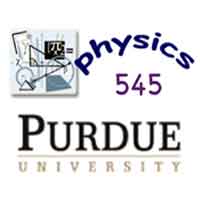Lecture 10: Tight Binding Approximation
We solve for the electronic states in a 1D crystal in the "tight binding" approximation. Rather than starting from the box of free electrons and adding the lattice in slowly (i.e. as a quantum mechanical perturbation), we work from the other limit today. This time, we'll assume the electrons are far from free, rather they're tightly bound to each atom. Start with a 1D cystal where the atoms are infinitely far apart, and we know the ground state of each electron. Now, slowly bring the atoms together, and electrons will begin to hop from one atom to the next. We treat this hopping as the quantum mechanical perturbation. Remarkably, this approach also gives a bandstructure similar to the case where we started from free electrons! Both limits have a little bit of truth to them, and some combination of these 2 effects happens in real materials.
As a special bonus, we play with the excellent program "Atom in a Box", available at www.daugerresearch.com. (Mac only.) We use the program to illustrate the difference between a stationary state (a state with a pure energy -- i.e. an eigenstate of the energy), and a nonstationary state (a state with a mixed energy -- one that adds 2 eigenstates with different energies.) Be sure and play with the program -- you'll see that the nonstationary states have a "wobbly' probability density. That is the sense in which they are not stationary.
Lecture Audio
As a special bonus, we play with the excellent program "Atom in a Box", available at www.daugerresearch.com. (Mac only.) We use the program to illustrate the difference between a stationary state (a state with a pure energy -- i.e. an eigenstate of the energy), and a nonstationary state (a state with a mixed energy -- one that adds 2 eigenstates with different energies.) Be sure and play with the program -- you'll see that the nonstationary states have a "wobbly' probability density. That is the sense in which they are not stationary.
Lecture Audio

